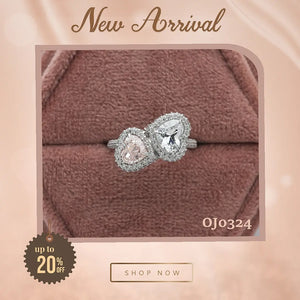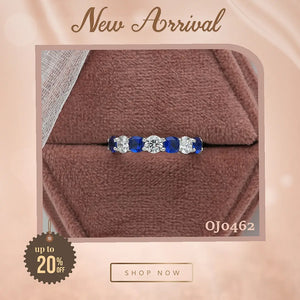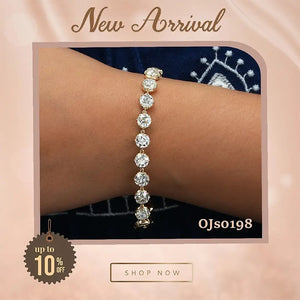Diamond Color Chart: Scale & Grading Guide and Choose Your Perfect Diamond
![[Diamond Color Scale Guide: Choose Your Perfect Diamond]-[ouros jewels]](https://cdn.shopify.com/s/files/1/0527/7669/8040/files/Diamond_Color_Scale_Guide_1024X512_50e02b8e-7f8f-4c08-b7c2-b5faa55a224d_2048x2048.webp?v=1714794292)
Diamond color significantly affects the overall look of your diamond. The color grading scale is from D (totally colorless) to Z (with a warm yellow color). Top-grade colorless diamonds (D-F) are pure but expensive, with prices starting at ($6,000-$7,000) for a 1 carat diamond. Near-colorless diamonds (G-J) are a great deal, with 1 carat stones starting about ($4,000-$4,500) saving you roughly (28%-35%) while looking beautiful.
This guide will help you understand diamond color and how to choose diamonds that look colorless to the human eye, ensuring you receive the best value. We'll also explain how the diamond's setting and shape affect color perception, so you can make the right choice and get the best value for money.
What is Diamond Color?
Diamond color connects to how colorless a diamond is, which affects its look and value. The Gemological Institute of America grades diamonds on a scale ranging from D to Z. A 'D' grade indicates a perfectly colorless diamond, which is the most valued and expensive, but a 'Z' grade indicates a diamond with visible yellow or brown colors, which is normally less valued. The less color a diamond has, the better it reflects light, which increases its brightness and sparkle.
Diamond Color Scale
The diamond color scale is important to analyzing a diamond's color and its effect on total value. It is from D, which means colorless, to Z, which has popular yellow or brown colors. The most valuable diamonds are colorless diamonds (D), which allow the most light to sparkle through. This scale helps buyers find out the quality of a diamond, which affects both its directed attraction and price. you'll look at how the scale works and why it's important to choose the proper diamond.
![[Diamond Color chart & grading Scale]-[ouros jewels]](https://cdn.shopify.com/s/files/1/0527/7669/8040/files/Diamond_Color_chart_grading_Scale_2048x2048.webp?v=1714802715)
GIA Diamond Color Grading Scale
GIA color grading checks a diamond's color to determine its value and attraction. To achieve proper color perception, this process is takes place in a controlled environment with consistent lighting. Diamonds are graded against a collection of master stones reflecting the color range from D (colorless) to Z (noticeable color), which helps in quality grading.
![[GIA Diamond Color Grading Scale ]-[ouros jewels]](https://cdn.shopify.com/s/files/1/0527/7669/8040/files/GIA_Diamond_color_Grading_Process_2048x2048.webp?v=1714802903)
Multiple gemologists may examine each diamond to confirm its color grade, ensuring similarity and accuracy. The final grade report is listed on GIA (Gemological Institute Of America) official website, which is useful for insurance and resale. This grading process is needed for buyers and sellers to understand the true grade and value of a diamond.
What is the Best Color for a Diamond?
Selecting the best diamond color is more about your style and money than exact advice. While D color diamonds are the most colorless so are the most expensive, G to I color diamonds may look similar yet cost far less. For example, a 1 carat D color diamond may cost significantly more than a H color diamond of the same size and quality, yet the color difference is just noticeable to the naked eye.
The look of the diamond is also affected by the setting used. Yellow or rose gold settings, for example, can make lower-color diamonds look colorless, allowing you to spend less money on a bigger diamond or a better setting. Finally, the best diamond color must satisfy your needs, suit the diamond's shape, match the setting metal, and be within your budget.
Fancy Color Diamonds Chart
Fancy colored diamonds chart is specifically different from that for white diamonds. White diamonds are graded on a D to Z scale to identify the presence of yellow or brown colors, while fancy colored diamonds are valued based on the strength and brightness of their color.
![[Fancy Colored Diamonds Color Scale]-[ouros jewels]](https://cdn.shopify.com/s/files/1/0527/7669/8040/files/Fancy_Colored_Diamonds_Color_Scale_600x600.webp?v=1714794932)
For fancy colored diamonds, the grading scale uses no letters but rather descriptive phrases ranging from the 'Faint' to the 'Most Vivid' color.
- Faint Color Diamond
- Very Light Color Diamond
- Light Color Diamond
- Fancy Light Color Diamond
- Fancy Color Diamond
- Fancy Intense Color Diamond
- Fancy Vivid Color Diamond
- Fancy Deep Color Diamond
- Fancy Dark Color Diamond
Fancy yellow diamonds graded "Faint" have some yellow color, somewhat more so than a Z-grade white diamond. "Fancy Intense" or "Fancy Vivid" diamonds, on the other hand, have a rich golden yellow color.
"Fancy Vivid" diamonds are brighter and more valuable than "Fancy Deep" or "Fancy Dark" diamonds. As a result, "Fancy Vivid" and "Fancy Intense" diamonds are in great demand and more expensive, but "Faint" or "Light" diamonds are more cost-effective and widely available. Color intensity has an important effect on market attractiveness and pricing.
The color of a diamond has an important effect on both its look and pricing. While colorless diamonds have traditionally been the most sought-after, many people now prefer diamonds with a little color for their unique and classic beauty.
How important is a diamond color?
A diamond's color affects its price, with colorless diamonds being the most costly. However, the best diamond for you should strike a balance between the 4 Cs—color, carat, cut, and clarity—while keeping within your budget. If you want a brilliant color, you may have to compromise on the diamond's size, cut, or clarity. If you put more importance on size or brightness, a near-colorless diamond may provide better overall value, allowing you to invest more in other essential features.
How to Select the Right Diamond Color?
When selecting the right diamond color, it is important to understand how multiple factors like shape, carat weight, and setting can impact the look of the diamond's color. This is how to select the best option:
![[How to Select the Right Diamond Color]-[ouros jewels]](https://cdn.shopify.com/s/files/1/0527/7669/8040/files/How_to_Select_the_Right_Diamond_Color_1024x1024.webp?v=1714795114)
1. Diamond Shape:
The shape of a diamond affects its color brightness. Because of the different facets, round brilliant cuts are excellent at hiding minor color tones. Diamonds with step cuts, like the princess cut, unique oval step cut, asscher cut or emerald cut, show more color because their facets are bigger and more open.
2. Diamond Carat Weight:
The size of the diamond affects how color is viewed. Larger diamonds show more color than smaller ones. For example, a 2 carat diamond with a faint blue color will display more color than a smaller diamond with the same color grade.
3. Diamond Setting:
The diamond setting's metal is very important. The best settings for colorless diamonds (grades D, E, and F) are platinum or white gold, which enhances their cool beauty. Yellow or rose gold settings work well for diamonds with just a little of yellow because they can soften the color and give comfort.
Diamond Color & Clarity
Diamond color and clarity are important factors that affect how a diamond looks, even they refer to different attributes. Higher scores indicate less color in a diamond. The color grade measures how colorless a diamond is. Clarity, on the other hand, looks at the presence of internal and outside marks called inclusions and spots etc.
To choose the best diamond, you can use colors and clarity guide. If you're not sure about which factor should come first, asking with a diamond expert like ouros jewels can provide specific advice. Generally speaking, the shape of the diamond and the style of the ring setting you select will impact if color or clarity is more important.
Conclusion: Choosing the Right Diamond Color and Clarity
Choosing the perfect diamond requires balancing color and clarity, both of which have a significant impact on its look and cost. Colorless diamonds are the most brilliant and costly of all diamond grades, which range from D (colorless) to Z (yellow or brown color). Diamonds that are nearly colorless can be a cost-effective option, providing a polished look for less money. The word "clarity" describes the possibility of flaws and is required to the diamond's brilliance. The diamond's overall looks is affected by its shape and setting, which also have an effect on how its color and clarity look. A diamond that suits your budget and style may be created by carefully considering elements like the diamond color, diamond clarity, diamond carat, and diamond cut. Getting advice from a diamond expert can help you make a choice that meets your needs and ensures your diamond shines brilliantly in its setting.
FAQs: Diamond Color
Q.1 What is the best color for a diamond?
Ans.The best diamond color is selected by your style and budget. While near-colorless diamonds (grades G to J) offer an equal opportunity between beauty and cost, colorless diamonds (grade D) are highly valued for their bright sparkle.
Q.2 What are Perfect Settings for Different Diamond Colors?
Ans. Colorless diamonds (D-F) look best in white gold or platinum settings that highlight their brightness, whereas yellow or rose gold settings may beautify slightly colored diamonds by masking problems.
Q.3 What are the 12 colors of diamonds?
Ans. Diamonds are found in a wide range of colors, from faint to vivid, including white (colorless), yellow, brown, blue, green, black, pink, orange, red, gray, purple, and violet.
Q.4 What is the color of a real diamond?
Ans. Real diamonds are typically graded from D to Z and can be colorless or in different shades of yellow and brown. They may also be found in beautiful colors like pink and blue, which are valued for their beauty and rarity.
Q.5 What is the Z color of a diamond?
Ans. The "Z" color of a diamond is the lowest grade on the Gemological Institute of America's (GIA) scale, which ranges from D (colorless) to Z (light color). Z-color diamonds have alight yellow, brown, pink, or grey. which makes them less expensive than colorless diamonds. However, they might still be important for their unique look for 100% sure jewelry designs in which warmer colors improve the overall beauty.
Q.6 What is Diamond Clarity?
Ans. Diamond clarity is the removal of inclusions (internal flaws) and spots (external flaws). It has a rating from Flawless (FL) to Included (I3), with better clarity indicating fewer visible flaws and higher value.
Q.7 Fancy Colored Diamonds: What Are They?
Ans. Fancy colored diamonds are valued for their beautiful colors in compared to white diamonds. From light to vibrant colors, their rating system highlights color saturation and richness; the richest colors are highly valued.
Q.8 How Important is Diamond Color Compared to Clarity?
Ans. The importance of color vs clarity depends on personal choice and the diamond's intended usage. While clarity is important for ensure a diamond's clear brilliance, color may be given primacy for its effect on a clean appearance without visible flaws.
Q.9 How Do Diamond Clarity and Color Affect the Look of Jewelry?
Ans. Best color and clarity improve a diamond's beauty in jewelry, making the stone sparkles brilliantly and looks flawless, maximizing both style and value.
Q.10 How Does Diamond Color Affect Price?
Ans. The color of a diamond impacts its price. Because of their rarity and strong demand, colorless diamonds (D-F) are the most expensive; in addition, near-colorless (G-J) and almost colored (K-M) diamonds are less expensive but still have an attractive look.
Recent Posts
-
How to Clean Gold Jewelry at Home
May 18, 2024 -
What Are Ouros Jewels Diamonds: Your FAQs Answered
May 16, 2024 -
What is the Value of Tanzanite
May 15, 2024 -
What Are Blood Diamonds? FAQs
May 14, 2024 -
The Ultimate Guide To Chain Lengths For Men
May 13, 2024 -
What Is Rhodium Plating: Everything You Need to Know
May 11, 2024 -
How To Clean Jewelry At Home
May 11, 2024
![[Ouros Jewels Officla Logo]](http://www.ourosjewels.com/cdn/shop/files/Ouros_Logo_Cap-02_e8b5c4d5-7168-48f6-aa08-6f82bb5c7397_480x200.png?v=1672033260)
 Brilliant Cut Rings
Brilliant Cut Rings
 Old Cut Rings
Old Cut Rings
 Colored Diamond Ring
Colored Diamond Ring
 Antique Diamond Ring
Antique Diamond Ring
 Salt & Pepper Ring
Salt & Pepper Ring
 Solitaire Rings
Solitaire Rings
 Halo Ring
Halo Ring
 Bridal Set
Bridal Set
 Solitaire Accent
Solitaire Accent
 Three Stone Ring
Three Stone Ring
 Semi Mount Ring
Semi Mount Ring
 Bezel Set
Bezel Set
 Pave Set
Pave Set
 Eternity Band
Eternity Band
 Channel Set
Channel Set
 Dainty Rings
Dainty Rings
 Toi Moi Rings
Toi Moi Rings


 Colored Diamond
Colored Diamond
 Old Cut Diamond
Old Cut Diamond
 Antique Shapes
Antique Shapes
 Diamond Layout
Diamond Layout
 Brilliant Cut
Brilliant Cut
 Certified Stone
Certified Stone
 Matching Pairs
Matching Pairs
 Gemstones
Gemstones
 Best Sellers
Best Sellers


 Studs
Studs
 Drop & Dangle
Drop & Dangle
 Hoop Earrings
Hoop Earrings
 Pendants
Pendants
 Necklaces
Necklaces
 Birthday Special
Birthday Special
 Anniversary Special
Anniversary Special
 Bracelets
Bracelets
 Bangles
Bangles
 Chain
Chain
 Ring
Ring
 Bracelet
Bracelet
 100-299$
100-299$
 300-499$
300-499$
 500$ and More
500$ and More

![[Ouros Jewels Officla Logo]](http://www.ourosjewels.com/cdn/shop/files/Ouros_Logo_Cap-02_e8b5c4d5-7168-48f6-aa08-6f82bb5c7397_5001x2084.png?v=1672033260)
![[How to Clean Gold Jewelry At Home]-[ouros jewels]](http://www.ourosjewels.com/cdn/shop/articles/How_to_Clean_Gold_Jewelry_At_Home_Main_Banner_1024X512_99f6baf0-30b0-4e90-aebb-a1ea0ab1386a_small.webp?v=1716023367)
![[Ouros jewels JCK Show May 31 - June 3, 2024, Booth No. 6149 at the Venetian Expo in Las Vegas]-[ouros jewels]](http://www.ourosjewels.com/cdn/shop/articles/Ouros_jewels_JCK_Show_May_31_-_June_3_2024_Booth_No._6149_at_the_Venetian_Expo_in_Las_Vegas_small.webp?v=1715944473)
![[What Are Ouros Jewels Diamonds: Your FAQs Answered]-[ouros jewels]](http://www.ourosjewels.com/cdn/shop/articles/What_Are_Ouros_Jewels_Diamonds_small.webp?v=1715851312)
![[What is the Value of Tanzanite]-[ouros jewles]](http://www.ourosjewels.com/cdn/shop/articles/What_is_the_Value_of_Tanzanite_1024X512_2811476a-df3d-45ea-98dd-cd54beac51d2_small.webp?v=1715775262)
![[What Are Blood Diamonds Your All FAQs]-[ouros jewels]](http://www.ourosjewels.com/cdn/shop/articles/What_Are_Blood_Diamonds_Your_FAQs_1024X512_493e32cc-b87e-499d-8147-ac8c695ebbcf_small.webp?v=1715677971)
![[The Ultimate Guide To Chain Lengths For Men]-[ouros jewels]](http://www.ourosjewels.com/cdn/shop/articles/The_Ultimate_Guide_To_Chain_Lengths_For_Men_small.webp?v=1715593003)

![[How to clean jewelry at home]-[ouros jewels]](http://www.ourosjewels.com/cdn/shop/articles/How_to_clean_jewelry_at_home_1024X512_d2db4c5c-b7e8-4ec1-85f6-55273b08dd3c_small.webp?v=1715421209)
![[Simulant Diamonds vs. Lab-Created Diamonds: Understanding the Difference]-[ouros jewels]](http://www.ourosjewels.com/cdn/shop/articles/imulant_Diamonds_vs_Lab_Created_Diamonds_1024X512_064dd6a4-27bb-4f4d-9a5d-9cc1b21a82ce_small.webp?v=1715163572)
![[How to Wear a Wedding Ring Correctly]-[ouros jewels]](http://www.ourosjewels.com/cdn/shop/articles/How_to_Wear_a_Wedding_Ring_Correctly_1024X512_fdaad541-5731-4bac-ac09-69ae0869651a_small.webp?v=1715073378)
![[What is a Promise Ring, And What Does It Represen]-[ouros jewels]](http://www.ourosjewels.com/cdn/shop/articles/What_is_a_Promise_Ring_And_What_Does_It_Represent_1024X512_bd01abd4-897f-4678-8ee6-47bc832dbb9c_small.webp?v=1714969539)